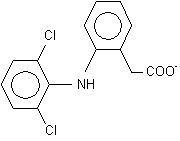NEW YORK -- Javelin Pharmaceuticals, Inc. (OTC BB: JVPH) announced today that Dyloject(TM) (diclofenac sodium injection) met the primary endpoint of a linear dose-response for pain relief over 6 hours as measured on the Visual Analog Scale (VAS). In this phase IIb study, patients with moderate to severe pain after oral surgery given a single dose of either Dyloject(TM) or Ketorolac tromethamine experienced statistically significant pain relief over 6 hours compared to patients who received placebo. Five minutes after intravenous injection, Dyloject(TM) demonstrated superior onset of pain relief to Ketorolac as measured by statistically significant reductions in pain intensity and pain relief using both the VAS and Categorical scales.
According to Dr. Daniel Carr, Javelin's Chief Executive Officer and Chief Medical Officer - "These exciting new results extend the consistently positive efficacy and safety outcomes seen in Javelin's prior clinical trials for Dyloject(TM). In this trial, the rapid onset and wide range of effective doses suggest this new injectable diclofenac product is remarkably effective at rapidly reducing pain in postsurgical patients. An earlier study of Dyloject(TM) showed superior efficacy and safety compared to Novartis's Voltarol(R), a different formulation of injectable diclofenac marketed in Europe. Now we've demonstrated faster pain relief compared to Ketorolac, the sole competing product in the U.S. marketplace. Rapid control of pain has obvious practical benefits for patients and the clinicians who care for them. These new findings from our clinical development program indicate that Dyloject(TM) offers a real improvement over existing products for acute pain control."
The study, DFC-002, included 353 patients with moderate-to-severe postsurgical pain who were randomized to receive one of five dose levels of Dyloject(TM) ranging up to 75 mg, IV Ketorolac tromethamine 30 mg, or placebo. Single doses of Dyloject(TM) showed, dose-dependent analgesic response as compared to patients given placebo, with overall analgesic effects similar to Ketorolac. Further analyses of the data are ongoing and will be submitted for presentation at an upcoming medical meeting.
Preliminary analysis of the data did not reveal unexpected safety signals and there were no serious adverse events related to study drug. General adverse events related to Dyloject(TM) were consistent with diclofenac's previously known pharmacologic effects including nausea, dizziness, headache and infusion site burning. Confirming and extending results of earlier trials of Javelin's Dyloject(TM), these favorable new results indicate that Dyloject(TM) may offer a safe, non-opiate analgesic alternative for the treatment of acute moderate-to-severe pain.
About the Study
A total of 353 postsurgical patients from the United States were randomized in this multi-center, double-blind, placebo- and comparator-controlled study. Each patient received a single bolus intravenous injection of Dyloject(TM), IV Ketorolac tromethamine or placebo. After dosing, patients were observed up to 24 hours post dose and returned to the clinic for a follow-up safety visit 5-9 days post dosing. In this "blinded" study, patients received treatments whose identity was not known by either the Investigator or the patient.
About Dyloject(TM)
Dyloject(TM), an injectable nonsteroidal anti-inflammatory drug (NSAID) has analgesic, anti-inflammatory and antipyretic activity. Diclofenac, the same active ingredient in Dyloject(TM), Voltaren(R), Cataflam(R) and Voltarol(R), is a leading analgesic for the treatment of moderate-to-severe postsurgical pain and has a demonstrated history of efficacy and safety as an NSAID since its approval in 1981. The safety of short-term use of diclofenac, which is a nonselective NSAID and not a selective COX-2 inhibitor, has been reaffirmed in recent white papers issued in 2005 by European and U.S. regulatory agencies. Historically, diclofenac has been used to treat pain from inflammatory and degenerative forms of osteoarthritis, musculoskeletal conditions, acute attacks of gout, kidney stones, and after operations or trauma. Currently, the only injectable form of diclofenac in Europe and other parts of the world is Voltarol(R). Voltarol(R) requires a slow (30 minutes or longer) infusion of a solution that is freshly prepared for each patient and is not available in the United States. Dyloject(TM) is a new Javelin formulation utilizing the same active ingredient as Voltarol(R), but is given as a single, brief injection. Worldwide, no comparable formulation of diclofenac has been available previously.
About Javelin Pharmaceuticals, Inc.
Javelin is a specialty pharmaceutical company, applying innovative, proprietary technologies to develop new drugs and improved formulations of existing drugs to target unmet and underserved medical needs in the pain management market. For additional information please visit the website www.javelinpharmaceuticals.com.
This news release contains forward-looking statements. Such statements are valid only as of today, and we disclaim any obligation to update this information. These statements are subject to known and unknown risks and uncertainties that may cause actual future experience and results to differ materially from the statements made. These statements are based on our current beliefs and expectations as to such future outcomes. Drug discovery and development involve a high degree of risk. Factors that might cause such a material difference include, among others, uncertainties related to the ability to attract and retain partners for our technologies, the identification of lead compounds, the successful preclinical development thereof, the completion of clinical trials, the FDA review process and other governmental regulation, our ability to obtain working capital, our ability to successfully develop and commercialize drug candidates, and competition from other pharmaceutical companies.
COPYRIGHT 2006 Business Wire
COPYRIGHT 2006 Gale Group



